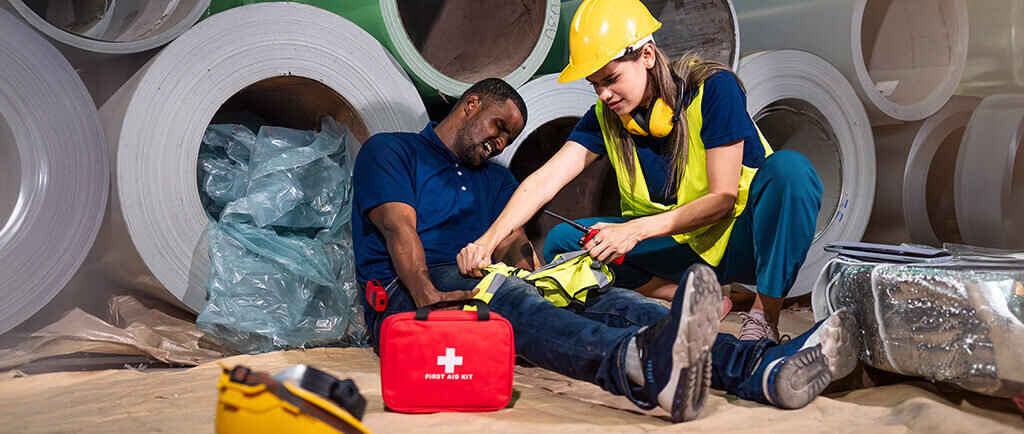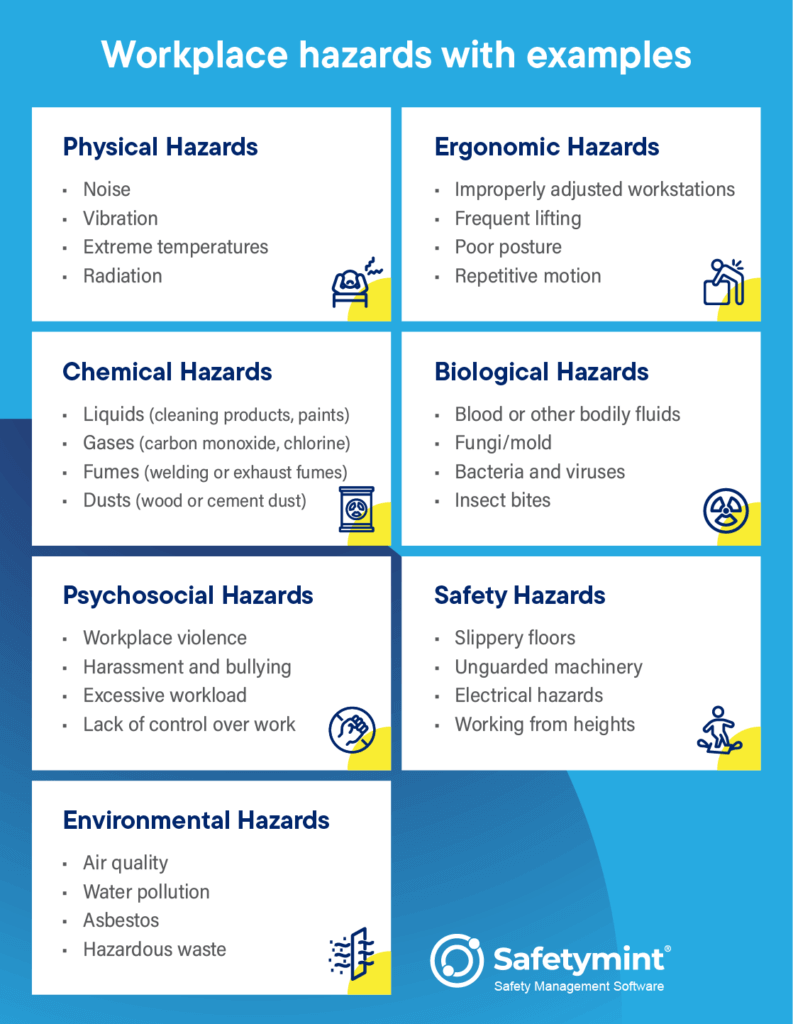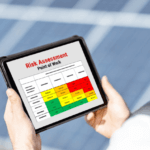
Top 7 Types of Workplace Hazards
What Are Workplace Hazards?
Every day, millions of people head to work with one common expectation: to return home safely. Yet, the workplace can be filled with unseen dangers that threaten this basic hope. Recognizing and understanding these dangers is the first step towards prevention. Workplace hazards are any aspects of work that have the potential to cause harm, be it physical injury, psychological stress, or health problems. Let’s break down the main types of hazards you might encounter:
- Physical Hazards
- Ergonomic Hazards
- Chemical Hazards
- Biological Hazards
- Psychosocial Hazards
- Safety Hazards
- Environmental Hazards
Each of these categories represents a different way that workers can be harmed on the job. Identifying them is crucial for creating a safer workplace for everyone.

Physical Hazards
Physical hazards are one of the most common workplace risks, stemming from environmental factors that can harm an employee without direct contact. These hazards can lead to injuries or health issues through exposure or interaction with the physical environment of the workplace.
Noise: Continuous exposure to loud environments can lead to hearing loss.
Vibration: Regular use of vibrating machinery can cause conditions such as hand-arm vibration syndrome.
Extreme temperatures: Working in excessively hot or cold environments can lead to heat stress or hypothermia.
Radiation: Exposure to ultraviolet, infrared, or microwave radiation can cause burns or long-term health effects.
Ergonomic Hazards
Ergonomic hazards occur when the type of work, body positions, and working conditions put strain on your body. They are the hardest to spot, as they don’t always immediately result in injury, but over time, they can severely affect an employee’s health and productivity.
Improperly adjusted workstations: Can lead to back pain or eye strain.
Frequent lifting: Of heavy objects can cause musculoskeletal injuries.
Poor posture: From sitting or standing incorrectly for long periods.
Repetitive motion: Can result in conditions like carpal tunnel syndrome.
Chemical Hazards
Chemical hazards are present when a worker is exposed to any chemical compound that could harm their health. These can exist as solids, liquids, gases, mists, or fumes, and the danger varies widely between substances.
Liquids: Such as cleaning products, paints, acids, and solvents.
Gases: Like carbon monoxide, chlorine, and ammonia.
Fumes: From welding or any type of exhaust.
Dusts: Of wood, cement, or asbestos.
Biological Hazards
Biological hazards come from working with people, animals, or infectious plant material. Jobs in healthcare, laboratory, outdoor, and other similar environments can expose workers to these hazards.
Blood or other bodily fluids: Can transmit diseases.
Fungi/mold: Exposure can cause respiratory issues.
Bacteria and viruses: Can lead to a variety of infectious diseases.
Insect bites: Can transmit diseases or cause allergic reactions.
Psychosocial Hazards
Psychosocial hazards affect employees’ psychological health, potentially leading to stress, burnout, or more serious mental health issues. These hazards stem from the design and management of work, and the social contexts of work.
Workplace violence: From colleagues or clients.
Harassment and bullying: Creating a hostile work environment.
Excessive workload: Leading to stress and burnout.
Lack of control: Over work processes and outcomes.
Safety Hazards
Safety hazards are unsafe working conditions that can lead to injury or illness. They are perhaps the most straightforward in terms of identification and mitigation.
Slippery floors: Can cause falls.
Unguarded machinery: Poses a risk of entanglement or amputation.
Electrical hazards: From exposed wiring or wet conditions.
Working from heights: Without proper fall protection.
Environmental Hazards
Environmental hazards arise from the workplace or the work environment’s impact on the wider environment. These hazards can affect health through exposure to air, water, soil pollution, and other environmental factors.
Air quality: Issues due to pollutants, dust, or mold.
Water pollution: Affecting clean drinking water sources.
Asbestos: Exposure in older buildings can cause respiratory issues.
Hazardous waste: Handling and disposal pose risks of exposure and contamination.
Leverage Safetymint to Identify and Manage Workplace Hazards

Understanding workplace hazards is the first step towards creating a safer work environment. However, identifying and managing these hazards efficiently requires the right tools. Safetymint inspection software is designed to empower your organization to proactively address workplace hazards through advanced, user-friendly features.
With Safetymint’s easy template builder, creating customized inspection checklists to identify specific hazards has never been simpler. Whether you’re assessing ergonomic risks, chemical exposures, or safety threats, our software allows you to tailor inspections to meet your unique workplace needs.
Conducting audits or inspections is streamlined with Safetymint, allowing for comprehensive assessments directly from your mobile or tablet device. This flexibility ensures that inspections are not only thorough but can be performed with ease, anywhere, anytime.
Once hazards are identified, Safetymint’s action tracker dashboard becomes an invaluable tool for assigning corrective actions to responsible individuals within your organization. This not only fosters a culture of accountability but also ensures that identified risks are addressed promptly and efficiently.
Key Features of Safetymint Inspection Management system:
Easy Template Builder: Create customized checklists to identify a wide range of hazards.
Mobile Inspections: Conduct and record inspections on-the-go, directly from your mobile or tablet.
Action Assignments: Assign corrective actions to team members, enhancing accountability.
Action Tracking Dashboard: Monitor the progress of assigned actions to ensure timely resolution of identified hazards.
Embrace a proactive approach to safety management with Safetymint. Start with a free trial to explore how our software can transform your safety practices. For a more in-depth understanding and to see Safetymint in action, schedule a demo with our team
Ben Johnson is a dedicated Customer Success Executive at Safetymint. With a strong commitment to excellence, Ben works closely with customers to ensure they fully leverage the capabilities of Safetymint to its fullest potential, aiming to significantly reduce or mitigate safety risks and incidents.







